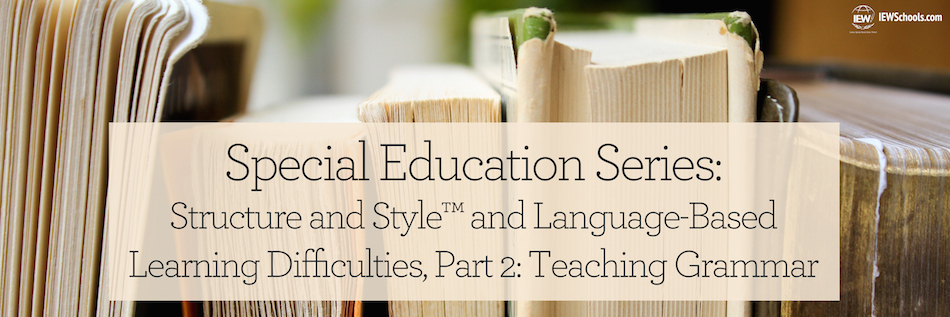
by Linda Mikottis and Jean Nichols
In part one of this series, we described the importance of a multi-sensory approach to language development and how IEW’s Structure and Style™ key word outline method incorporates listening, speaking, reading, and writing into each lesson. In part two, we will share some of the research on what works in grammar instruction and explain how IEW’s teaching of stylistic techniques and our Fix It! Grammar materials are an effective way to teach grammar skills to students, particularly those with language-based learning disabilities.
Traditional Grammar Instructional Methods Do Not Work
Correct grammar usage is a critical language skill. We can't communicate effectively without it, yet there is little agreement on the best way to teach it. Learning grammar in isolation using textbook exercises or worksheets where students underline parts of speech, fill in blanks, or diagram sentences rarely transfers to their written work. In fact, when the National Council of Teachers of English (NCTE) published its first comprehensive survey about the teaching of writing in 1963, they condemned grammar instruction, stating “[T]he teaching of formal grammar has a negligible or, because it usually displaces some instruction and practice in actual composition, even a harmful effect on the improvement of writing …” (Linden and Whimbey 1990).
Grammar instruction did not improve in the ensuing decades. Their 1990 report concluded,
If schools insist upon teaching the identification of parts of speech, the parsing or diagramming of sentences, or other concepts of traditional school grammar (as many still do), they cannot defend it as a means of improving the quality of writing (Linden and Whimbey 1990).
This long-held, misguided belief that students must learn grammar before they can write, rather than learning grammar through writing, is both wrong and harmful (Cleary 2014). Taught in isolation, grammar may seem to serve no purpose. When we write, we are directly applying grammar. When skills are modeled by the teacher and practiced purposely, students will begin to recognize grammar rules and learn to use them effectively.
How is Grammar Taught in the Structure and Style Method?
Through IEW’s Structure and Style process, students discover the purpose of grammar. One subject enhances the other. Students’ attitudes about grammar improve when they see the need for it. They still may not think grammar is fun, but it does become easier. As students brainstorm banned word alternatives in a class discussion and must later use a required strong verb or quality adjective in a composition, they are applying grammar rules. When a child encounters a part of speech in her English textbook, she realizes, “Hey, I know what an adjective is. I use it in my writing!”
In “The Wrong Way to Teach Grammar,” Michelle Navarre Cleary cites numerous studies that indicate that, in addition to lots of reading and writing, effective grammar instruction includes teaching students strategies for revising and editing, developing mini-lessons targeted to the kinds of errors and problems students make in their own writing, and having students “play with sentences like Legos,” combining basic sentences into more complex ones (Cleary 2014). Andrew Pudewa has also used a Lego® analogy to describe the “coordinated pieces and a plan” power of the key words, word lists, and checklists of the Structure and Style approach. When students select and insert dress-ups and sentence openers into their writing, they have many opportunities to combine simple sentences into complex ones.
These strategies are also featured in Fix It! Grammar, a series created by IEW to teach revising, editing, and grammar at the point of need. In the context of an ongoing classic story, students hunt for and correct embedded errors in two or three sentences of the story each day, and over the course of the year, learn to apply grammar rules to the writing. Taking only fifteen minutes a day to complete, students learn to think about their writing and, in incremental steps, how to apply grammar rules to written work and edit their own writing. While Fix It! Grammar is an excellent and effective instructional resource for students of every ability, your special needs students will find it a particularly engaging way to learn essential grammar and editing skills.
In parts one and two of this series, you have discovered that the Institute for Excellence in Writing provides a comprehensive, multi-sensory approach to writing that incorporates listening, speaking, reading, and writing. Children with learning challenges and those who struggle with writing are encouraged by the systematic method of introducing structure and style into their compositions. Beginning with the key word outline, children are taught to think sequentially while building vocabulary and English grammar skills. Telling the story back from the outline, the child cements syntax, vocabulary, and content thereby enriching his learning experience. The discovery of English grammar rules while writing reinforces the skills taught in the child’s grammar book. Abstract and obscure grammar rules become clear, concrete, and immediately applicable when they are taught within the context of writing.
In the final part of this three-part series, we will focus on the use of the checklist and describe how this indispensable IEW tool supports special education students by making writing and revising expectations explicit while simultaneously facilitating student accountability, self-assessment, and independence.
For more information about IEW’s time-tested success in serving the needs of special education students through grammar instruction, we invite you to listen to these three-part episodes from our Arts of Language podcast: “Special Education: Struggles and Suggestions” and “The Great Grammar Give-and-Take.”
Works Cited
Cleary, Michelle Navarre. "The Wrong Way to Teach Grammar." The Atlantic. Atlantic Media
Company, 25 Feb. 2014.
[https://www.theatlantic.com/education/archive/2014/02 the-wrong-way-to-teach-grammar/284014/].
Accessed 02 July 2017.
Linden, Myra J., and Arthur Whimbey. Why Johnny Can't Write: How to Improve Writing Skills.
L. Erlbaum, 1990.
Pudewa, Andrew. "The LEGOs® of Language." Institute for Excellence in Writing L.L.C. 19 Apr.
2014, http://iew.com/schools/help-support/resources/articles/legos-of-language. Accessed 02 July 2017.
Structure and Style is a trademark of the Institute for Excellence in Writing, L.L.C.
LEGO® is a registered trademark of the LEGO Group of companies which does not sponsor, authorize, or endorse this site.
|
Jean Nichols brings 34 years of classroom experience to IEW, having taught grades 1–6 in New York, Virginia, and in California, where she taught sixth-grade language arts in the Rocklin Unified School District. She was introduced to IEW in 2001 when a colleague shared Student Writing Intensive videos at weekly school staff meetings. As a result of student progress and teacher enthusiasm at her school, RUSD brought Andrew Pudewa to Rocklin many times over the next several years to train district teachers, resulting in improved student writing and test scores district-wide. Named Rocklin’s “Elementary Teacher of the Year” in 2001, Jean was also included in the 2004 and 2005 editions of Who’s Who Among America’s Teachers. |
|
 |
Linda Mikottis, BS SP ED, EL ED, and Accomplished IEW Instructor, is probably the least likely writing teacher you will ever meet. Never having learned to write well in school, she was convinced one was either born with the gift of writing or not. After discovering the Institute for Excellence in Writing methodology in 1996, Linda finally learned to write at the age of 34. No longer intimidated by writing, she was determined that others would not grow up as she did. Many of her successful students have been diagnosed with Asperger syndrome, learning disabilities, dyslexia, ADD, and ADHD. Linda now empowers children by empowering teachers through the hope IEW has to offer. |

